
330 North Wabash is a skyscraper in downtown Chicago, Illinois, United States, at 330 N. Wabash Avenue, designed by the architect Ludwig Mies van der Rohe. A small bust of the architect by sculptor Marino Marini is displayed in the lobby. The 52-story building is situated on a plaza overlooking the Chicago River. At 695 feet, 330 North Wabash is the second-tallest building by Mies van der Rohe, the tallest being the Toronto-Dominion Bank Tower at Toronto-Dominion Centre. It was his last American building.

The Reliance Building is a skyscraper located at 1 W. Washington Street in the Loop community area of Chicago, Illinois. The first floor and basement were designed by John Root of the Burnham and Root architectural firm in 1890, with the rest of the building completed by Charles B. Atwood in 1895. It is the first skyscraper to have large plate glass windows make up the majority of its surface area, foreshadowing a design feature that would become dominant in the 20th century.

The Inland Steel Building is a skyscraper located at 30 W. Monroe Street in Chicago, Illinois. It is one of the city's defining commercial high-rises of the post-World War II era of modern architecture. Its principal designers were Bruce Graham and Walter Netsch of the Skidmore, Owings & Merrill architecture firm. The building is managed and leased by MB Real Estate. The Inland Steel Building was designated a Chicago Landmark in 1998.

The Schiller Piano Company was an American manufacturer of pianos in Oregon, Illinois. It operated independently from 1890 to 1936, when it merged with the Cable Company and thereafter produced pianos under the name Cable and Conover. Thousands of pianos were produced in its factory, which was operated by corporate successors until 1971. The 120,000-square-foot (11,000 m2), stucco-clad building was renovated for use as an indoor mall in 1975 and today operates as the Conover Square Mall.

Pullman National Historical Park is a historic district located in Chicago, Illinois, United States, which in the 19th century was the first model, planned industrial community in the United States. The district had its origins in the manufacturing plans and organization of the Pullman Company and became one of the most well-known company towns in the United States, as well as the scene of the violent 1894 Pullman strike. It was built for George Pullman as a place to produce the Pullman railroad-sleeping cars.
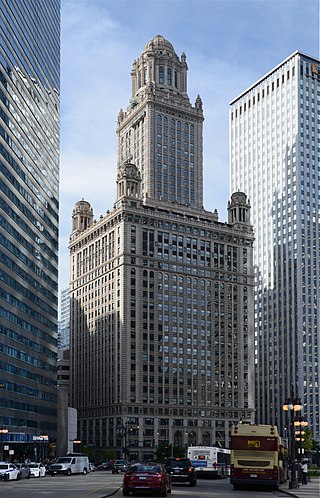
35 East Wacker, also known as the Jewelers' Building, is a 40-story 523 ft (159 m) historic building in the Loop community area of Chicago, Illinois, United States, located at the intersection of Wabash Avenue and East Wacker Drive, facing the Chicago River. It was built from 1925 to 1927, and was co-designed by Joachim Giæver and Frederick P. Dinkelberg. At the time of its completion in 1927, it was the tallest building in the world outside New York City. Formerly the Pure Oil Building and North American Life Insurance Building, 35 East Wacker was listed in 1978 as a contributing property to the Michigan–Wacker Historic District on the National Register of Historic Places, and was designated a Chicago Landmark on February 9, 1994.

The E. V. Haughwout Building is a five-story, 79-foot-tall (24 m) commercial loft building in the SoHo neighborhood of Manhattan, New York City, at the corner of Broome Street and Broadway. Built in 1857 to a design by John P. Gaynor, with cast-iron facades for two street-fronts provided by Daniel D. Badger's Architectural Iron Works, it originally housed Eder V. Haughwout's fashionable emporium, which sold imported cut glass and silverware as well as its own handpainted china and fine chandeliers, and which attracted many wealthy clients – including Mary Todd Lincoln, who had new official White House china painted here. It was also the location of the world's first successful passenger elevator.
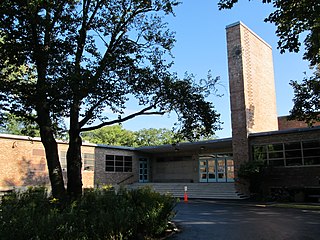
Crow Island School in Winnetka, Illinois, is an elementary school operated by Winnetka Public Schools. It is significant for its progressive philosophy and its International Style architecture. The design of its building was a collaboration between the Chicago firm of Perkins, Wheeler and Will and Eliel and Eero Saarinen. It currently serves kindergarten through fourth grade students. The school was established in 1940-41. Sebastian Hinton's prototype "jungle gym" was located here, having been moved from Horace Mann School in 1940 and then relocated to the Winnetka Historical Society in 2010. The school was awarded the Twenty-five Year Award by the American Institute of Architects in 1971. It was declared a National Historic Landmark in 1990. In celebration of the 2018 Illinois Bicentennial, Crow Island School was selected as one of the Illinois 200 Great Places by the American Institute of Architects Illinois component.
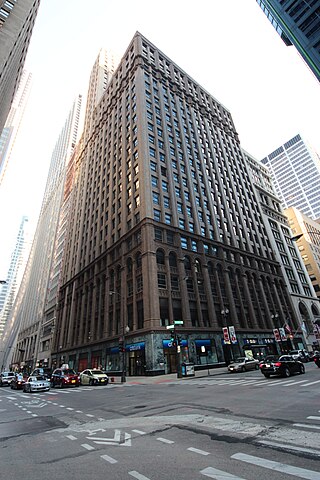
11 South LaSalle Street Building or Eleven South LaSalle Street Building is a Chicago Landmark building that is listed on the National Register of Historic Places and that is located at 11 South LaSalle Street in the Loop community area of Chicago, Illinois, United States. This address is located on the southeast corner of LaSalle and Madison Street in Cook County, Illinois, across the Madison Street from the One North LaSalle Building. The building sits on a site of a former Roanoke building that once served as a National Weather Service Weather Forecast official climate site and replaced Major Block 1 after the Great Chicago Fire. The current building has incorporated the frontage of other buildings east of the original site of Major Block 1.
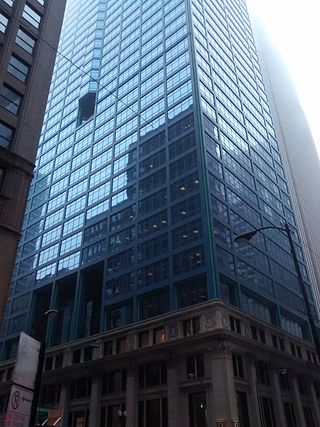

The Sheridan Flouring Mills, also known as the Mill Inn, are an industrial complex in Sheridan, Wyoming. The mills were a major component of the economy of north central Wyoming, providing collection, storage and milling of locally produced wheat and other grains into flour and other milled products. The original mill was established by Captain Scott W. Snively in the early 1890s. The Sheridan Milling and Manufacturing Company was sold to J.W. Denio in 1903, who operated the mill at its location on Broadway Avenue near downtown Sheridan. A catastrophic fire destroyed this mill in 1919, resulting in the purchase of a new location on Coffeen Avenue and construction of a much larger mill.
Otis Elevator Company Building may refer to:

The Burtis–Kimball House Hotel and the Burtis Opera House were located in downtown Davenport, Iowa, United States. The hotel was listed on the National Register of Historic Places in 1979. It has since been torn down and it was delisted from the National Register in 2008. The theatre building has been significantly altered since a fire in the 1920s. Both, however, remain important to the history of the city of Davenport.
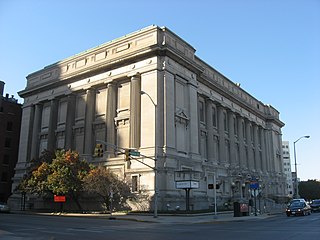
Rubush & Hunter was an architectural firm in Indianapolis, Indiana in the United States. Established in 1905 by architects Preston C. Rubush and Edgar O. Hunter, Rubush & Hunter operated until 1939.
The Otis Elevator Company Building is a commercial building located in northwest Portland, Oregon listed on the National Register of Historic Places.

Union Park Congregational Church and Carpenter Chapel is a historic church building at 60 N. Ashland Blvd. on the Near West Side of Chicago, Illinois. The chapel is named after Philo Carpenter, a deacon, a co-founder of the congregation and of the Chicago Theological Seminary, and an early donor of the original church who was also a noted abolitionist and the city's first druggist. The two buildings are considered as a unit; together, they are a Chicago Landmark and an Illinois Historic Landmark and are listed on the National Register of Historic Places. The church building is currently occupied by the First Baptist Congregational Church, whose official mailing address is 1613 W. Washington Blvd. in Chicago.
The Vesta Battery Corporation (1897–1964), known until 1929 as the Vesta Accumulator Company, was an American manufacturer of automobile electrical gear. Based in Chicago, Illinois, the company was founded by a former garment worker in 1897. Originally intending to sell parts for electric bicycles, the company quickly diversified to manufacture electrical goods for the burgeoning automobile industry. At its peak, the company had branches in ten American cities. Vesta continued operations until it was purchased by Associated Battery Makers in 1964. Its 1913 factory in Chicago is listed on the National Register of Historic Places.

The Wholesale Florists Exchange is a historic building at 1313 W. Randolph Street in the Near West Side neighborhood of Chicago, Illinois. The building was constructed in 1927 to serve as a central market for several of Chicago's largest florists. Before the building opened, the city's floral industry was based at a crowded market on Wabash Street that lacked proper facilities for processing flowers. The new building, designed by architecture firm Fox & Fox, included amenities such as modern refrigeration and improved elevators and loading areas to facilitate efficient transport of flowers. It also featured an Art Deco design that incorporated floral themes, such as the lotuses atop its fluted concrete piers. The building served as the nexus of Chicago's floral industry until the 1950s, when the industry largely left Chicago for warmer regions of the country.

The Steelcote Manufacturing Company Paint Factory, at 801 Edwin in St. Louis, Missouri, was built in 1922. It was listed on the National Register of Historic Places in 2007.

Rapid City Fruit Company is a historic building at 320 7th Street in Rapid City, South Dakota. It was listed on the National Register of Historic Places in 1993.



















